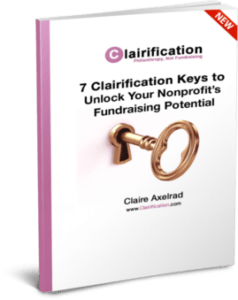
Stop being penny wise and pound foolish
Invest more.
That’s it.
It’s simple. And it works.
You see, penny-wise fundraising may seem smart. You may pat yourself on the back for working “lean and mean.” But, in actuality, lean and mean is the antithesis of how a nonprofit becomes successful.
Penny-wise fundraising ends up being nothing more than mean.
- Mean to the people to whom you pay pauper’s wages.
- Mean to the staff you overwork.
- Mean to the volunteers you burn out.
- Mean to the clients you can’t afford to help.
- Mean to the donors to whom you’re unable to offer satisfying philanthropic investment opportunities.
- Mean to the community you can’t afford to serve.
Penny-wise fundraising takes you down exactly the wrong pathway.
- Pathway to the nonprofit cycle of starvation.
- Pathway to buying what’s cheap, not what’s effective.
- Pathway to a culture of scarcity and need, rather than abundance and philanthropy.
- Pathway to a culture of resentment, rather than gratitude.
- Pathway to colluding in the nonprofit overhead myth.
You May Think You’re Being Smart, But You’re Not
Penny-wise fundraising reveals an underlying attitude fundraising is a “necessary evil.’ So… why not invest as little as possible in it?
Sadly, this approach to fundraising is doomed to failure.
When you’re engaged in evil work, no one wants to join you.
And few folks engaged in that work (staff and volunteers alike) will tend to enjoy it, let alone achieve success.
Without the proper tools and support to get results, after a short while they’ll throw up their hands in despair – leaving you and your nonprofit sadder and no wiser.
Think Hard: What Does Fundraising Mean to Your Organization?
Mary Cahalane of Hands On Fundraising wrote: If fundraising matters, you need to invest in it. Sager words were never uttered. I encourage you to read her full article, where she lays out the perils of well-intentioned scrimping and expedient short-term thinking.
Seriously ask yourself:
- What does fundraising make possible here?
- What would happen if we didn’t raise the money we do?
- What will happen if we don’t raise more money in the year ahead?
- What could we do with more philanthropy?
- What would happen if our organization ceased to exist?
When you pay staff the lowest salary you can get away with…

So sad you won’t invest in me
They won’t have the skills and experience you need, and they’ll leave before your investment in training them has time to pay off. Groundbreaking research from Penelope Burk found that average turn-over of development staff is just 16 months, and 48% said they left their last position to “seek a higher salary elsewhere.” Replacing these professionals averages $127,650 in direct and indirect costs. Amplifying this cost is the fact that when someone leaves other staff must step in to fulfill their responsibilities, causing their own work to suffer. Plus, fundamentally, effective fundraising is about building donor relationships. This clearly suffers when staff leave.
“Our people are truly our best resource. Wasting their time and energy foolishly is hurting our work. Paying them poorly means losing the best people – either because they’ll never work for you or because they can’t stay very long if they do.”
Mary Cahalane, Hands-On Fundraising
You may think you’re being smart, but you’re not.
When you invest in the el cheapo donor database, CRM or mail service…

So ticked you won’t invest in crucial support!
Your weak infrastructure will cripple your efforts. It won’t enable you to pull reports you need, segment your mailing lists effectively, track cultivation moves appropriately, or doe what’s necessary to track progress towards enhancing donor retention.
You won’t be able to create branded campaigns, build compelling donation landing pages, streamline user-friendly donation forms, develop recurring and peer-to-peer giving initiatives, or generally make your life easier in the long run.
You may think you’re being smart, but you’re not.
When you skimp on a staff development budget…

Can’t cope without investment in growth
You’ll get stuck in status quo mode. Staff won’t have access to the opportunities they need to learn, grow and adapt to changing realities. They won’t be able to bring new thinking and tools to their work that could make them, and your organization, more successful.
“In the private sector, we see companies with high-quality training and development programs generate 26% more revenue per employee and realize 40% less voluntary turnover than their peers. What if we translated this to the nonprofit sector? If we invested in training and developing staff who deliver these critical programs, would we see 26 percent or more impact per staff member? Would nonprofits achieve greater success because they could focus their people, time, and money on mission-driven activities rather than covering the cost of turnover?” — Julie Brandt, Stanford Social Innovation Review
You may think you’re being smart, but you’re not.
When you silo development staff and fail to include them in budgeting, strategic planning and board meetings…

Wish you’d value staff input
They won’t have the information and connections they need to succeed in inspiring donors to buy in to your vision, mission and values. Nor will you have the input you need to create sustainable plans and budgets capable of being balanced and even expanded.
“Development is a crucial part of facilitating your organization’s mission. As such, it should be embraced as a collective effort toward your organization’s maximum impact. No matter the size, scope, or mission of your nonprofit, your development staff is crucial in sustaining your operations for today and your impact for tomorrow.
— Ron Guisinger, Benefactor Group
You may think you’re being smart, but you’re not.
When you fail to develop an organization-wide customer service culture…

Don’t bother me; it’s not my job!
You ignore the fact it takes a village to fundraise successfully. Everyone pulling together, centered on the same mission and donor-centered focus. To your supporters, you are one organization. Everyone has a role in creating positive, productive relationships with your donors.
It only takes one rude receptionist, one disaffected, overworked, program staffer or one disgruntled board member to undermine the development staff’s hard work.
You may think you’re being smart, but you’re not.
When you consider short-term costs rather than long-term ROI…

Wish you’d stop being so short-sighted
You doom yourself to treading water. It simply costs money to make money. If instead you invest all your excess cash reserves in stocks and bonds, you limit your potential.
In fact, a study by United Kingdom fundraising guru Giles Pegram found organizations investing in fundraising rather than financial markets yielded a return of 3:1 over 0.5:1 – a remarkably dramatic result. When you fail to invest fundraising, you fail to reap rewards.
You may think you’re being smart, but you’re not.
When you adhere to a belief in low overhead as a holy grail…

Wish you’d get a clue what metrics matter
You’ll fail to correlate expenditures with impact or effectiveness. A charity that spends 20 percent on overhead and knocks its mission out of the ballpark is not less worthy of support than one that spends 10 percent on overhead but helps relatively few people. It’s one way of assessing things, but not necessarily the most meaningful.
It’s like cutting your medications in half because you can’t afford them. One aspirin won’t take away your head-ache if you need two.
You may think you’re being smart, but you’re not.
BOTTOM LINE:

Invest in the whole picture!
It makes zero sense to look at fundraising expenses in a vacuum, absent a look at results.
Use your common sense and good judgement more.
If you need a car to drive across the country within a reasonable time frame, it doesn’t make sense to buy an inexpensive old jalopy that’s going to break down every 50 miles or so. You may be in the driver’s seat, but it’s not going to be a successful journey.
To drive and work smart, you’ve got to consider desired outcomes first. Otherwise, you’re kidding yourself.
A ‘good deal’ is not such a good deal when it’s good on the front end only.
Stop being penny-wise and pound-foolish.
It’s not smart. Period.
Get the 7 Clairification Keys!
 Unlock your nonprofit’s fundraising potential through a series of “clairifying” worksheets and exercises.
Unlock your nonprofit’s fundraising potential through a series of “clairifying” worksheets and exercises.
- Values.
- Stories.
- Brand.
- Social Channels.
- Support Constituencies.
- Engagement Objectives.
- Resources and Systems.
Learn more HERE. As with all Clairification products, this comes with a 30-day 100% refund guarantee. If you’re not happy, I’m not happy.
Images from Pixabay and Robin Higgins






AWESOME POST… this is something we have to share with everybody… small and large organizations struggle with this. A LOT.
Thanks Erica! It would be great to see more foundations offering capacity building grants as well.
Wow! Good article!